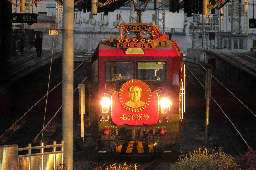High-speed rail (HSR) is a type of rail network utilizing trains that run significantly faster than those of traditional rail, using an integrated system of specialised rolling stock and dedicated tracks. While there is no single standard that applies worldwide, lines built to handle speeds above 250 km/h (155 mph) or upgraded lines in excess of 200 km/h (124 mph) are widely considered to be high-speed.
The first high-speed rail system, the Tōkaidō Shinkansen, began operations in Japan in 1964. The system also became known by its English nickname the bullet train. Japan's example was followed by several European countries, initially in France and Germany, and later also in Spain, Italy, and others. Today Europe has an extensive network with numerous international connections. More recent construction since the 21st century has led to China taking a leading role in high-speed rail. As of 2023, its network accounted for over two-thirds of the world's total.
In addition to these, many other countries have developed high-speed rail infrastructure to connect major cities, including Austria, Belgium, Denmark, Finland, Indonesia, Japan, Morocco, the Netherlands, Norway, Poland, Portugal, Russia, Saudi Arabia, Serbia, South Korea, Sweden, Switzerland, Taiwan, Turkey, the United Kingdom, the United States, and Uzbekistan. Only in continental Europe and Asia does high-speed rail cross international borders.
High-speed trains mostly operate on standard gauge tracks of continuously welded rail on grade-separated rights of way with large radii. However, certain regions with wider legacy railways, including Russia and Uzbekistan, have sought to develop a high speed railway network in Russian gauge. There are no narrow gauge high-speed trains.
High-speed rail is the fastest and most efficient ground-based method of commercial transportation, however due to requirements for large track curves, gentle gradients and grade separated track the construction of high-speed rail is more costly than conventional rail and therefore does not always present an economical advantage over conventional speed rail.
Megathreads and spaces to hang out:
- ❤️ Come listen to music and Watch movies with your fellow Hexbears nerd, in Cy.tube
- 💖 Come talk in the New Monthly queer thread
- 💛 Read about a current topic in the news
- ⭐️ October Movie Nominations ⭐️
reminders:
- 💚 You nerds can join specific comms to see posts about all sorts of topics
- 💙 Hexbear’s algorithm prioritizes struggle sessions over upbears
- 💜 Sorting by new you nerd
- 🌈 If you ever want to make your own megathread, you can go here nerd
- 🐶 Join the unofficial Hexbear-adjacent Mastodon instance toots.matapacos.dog
Links To Resources (Aid and Theory):
Aid:
- 💙Comprehensive list of resources for those in need of an abortion -- reddit link
- 💙Resources for Palestine
Theory:


On the flip side, it’s always nice having a friend that can hard carry.
I’ve been on both sides of this and sometimes a friend who is better really is nice to play with. Their experience is probably being made better by you being able to play the game on a higher level. Try viewing it as being a Sherpa, it adds extra challenges and goals.
For example, I want to get as many assists as possible. Friend X is going to top the leaderboard if I get my way.
Being good at something is good, there is always a way to use something you are good at to bring a greater amount of happiness to the world.
That's a good way to think of it. I really like playing support roles and helping the team succeed together.
Same! Support is the best.
It often requires the most game knowledge (the shorter queues help too)